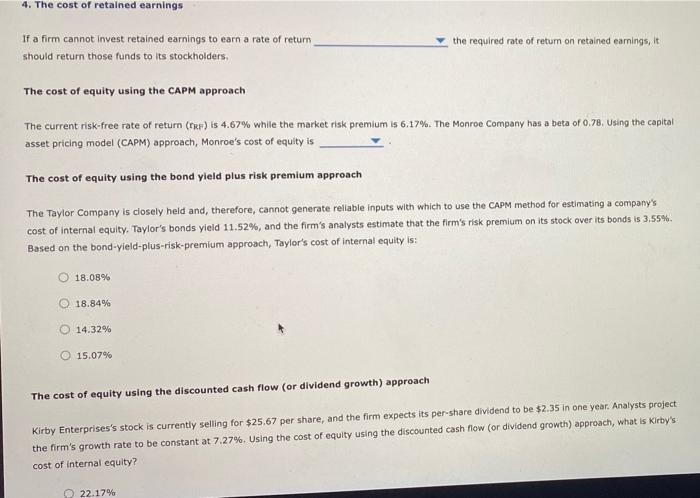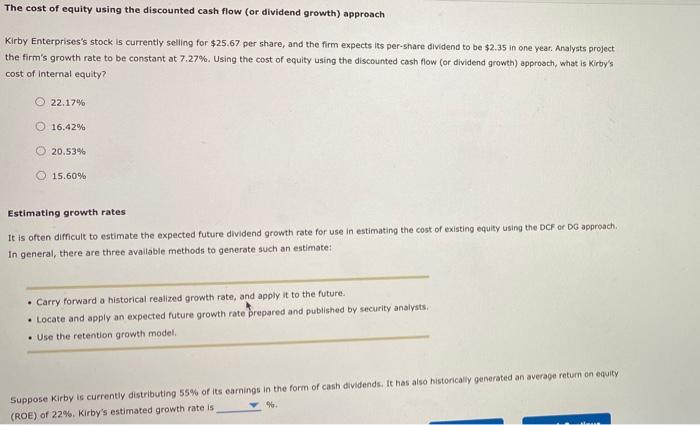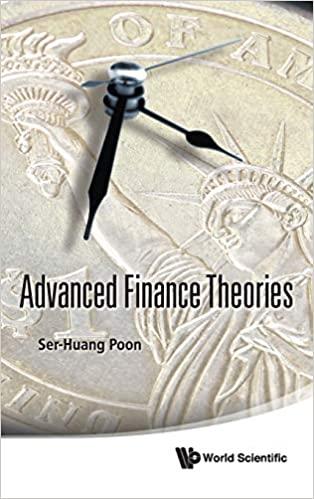Answered step by step
Verified Expert Solution
Question
1 Approved Answer
Please circle answers 4. The cost of retained earnings If a firm cannot Invest retained earnings to earn a rate of return should return those
Please circle answers 

4. The cost of retained earnings If a firm cannot Invest retained earnings to earn a rate of return should return those funds to its stockholders. the required rate of return on retained earnings, it The cost of equity using the CAPM approach The current risk-free rate of return (TRF) is 4.67% while the market risk premium is 6.17%. The Monroe Company has a beta of 0.78. Using the capital asset pricing model (CAPM) approach, Monroe's cost of equity is The cost of equity using the bond yield plus risk premium approach The Taylor Company is closely held and, therefore, cannot generate reliable inputs with which to use the CAPM method for estimating a company's cost of internal equity. Taylor's bonds yield 11.52%, and the firm's analysts estimate that the firm's risk premium on its stock over its bonds is 3,55%. Based on the bond-yield-plus-risk-premium approach, Taylor's cost of internal equity is: 18.08% 18.84% 14.32% @ 15.07% The cost of equity using the discounted cash flow (or dividend growth) approach Kirby Enterprises's stock is currently selling for $25.67 per share, and the firm expects its per share dividend to be $2.35 in one year. Analysts project the firm's growth rate to be constant at 7.27%. Using the cost of equity using the discounted cash flow (or dividend growth) approach, what is Kirby's cost of internal equity? 22.17% The cost of equity using the discounted cash flow (or dividend growth) approach Kirby Enterprises's stock is currently seling for $25.67 per share, and the firm expects its per-share dividend to be $2.35 in one year. Analysts project the firm's growth rate to be constant at 7.27%. Using the cost of equity using the discounted cash flow (or dividend growth) approach, what is Kirby's cost of Internal equity? 22.17% 16.42% 20.53% 15.60% Estimating growth rates It is often difficult to estimate the expected future dividend growth rate for use in estimating the cost of existing equity using the DCF or DG approach In general, there are three available methods to generate such an estimate: Carry forward a historical realized growth rate, and apply it to the future. Locate and apply an expected future growth rate brepared and published by security analysts. . Use the retention growth model. Suppose Kirby is currently distributing 55% of its earnings in the form of cash dividends. It has also historically generated an average return on equity (ROE) of 22%. Kirby's estimated growth rate is 9 

Step by Step Solution
There are 3 Steps involved in it
Step: 1

Get Instant Access to Expert-Tailored Solutions
See step-by-step solutions with expert insights and AI powered tools for academic success
Step: 2

Step: 3

Ace Your Homework with AI
Get the answers you need in no time with our AI-driven, step-by-step assistance
Get Started


